For Indian tech entrepreneurs, especially in the SaaS and product domains, the recent alterations in U.S. tax laws, particularly under IRS Section 174, signal a period of strategic evaluation and potential realignment. This development is pivotal for those who have long relied on the U.S. market.
Decoding IRS Section 174: A Shift in Tax Treatment
The Internal Revenue Service (IRS) of the United States has revised its stance on Research & Experimentation (R&E) amortization, as outlined in Section 174. Historically, companies could immediately expense R&E costs, but the new guidance mandates amortization over a five-year period for domestic expenses and 15 years for foreign expenses. This shift holds significant implications for software development and outsourcing practices, particularly for nations like India, a powerhouse in the global IT and tech outsourcing market.
Background:
- Previous System: Companies could immediately deduct their entire Research & Experimentation (R&E) expenses in the year they were incurred.
- New System: Under IRS Section 174, these expenses must now be amortized, meaning they are deducted over several years. The period is 5 years for domestic (U.S.) R&E expenses and 15 years for foreign (non-U.S.) R&E expenses.
Example:
Scenario: A U.S. Software Company Outsourcing to India
- Company: XYZ Corp, a U.S.-based software company.
- R&E Expense: $150,000 spent on software development in India in 2023.
Previous System (Immediate Expensing):
- In 2023, XYZ Corp could deduct the entire $150,000 from its taxable income.
New System (Amortization):
- Over 15 Years: The $150,000 must be divided over 15 years because it’s a foreign expense.
- Annual Deduction: $150,000 / 15 years = $10,000 per year.
- Impact: In 2023, XYZ Corp can only deduct $10,000 of the $150,000 expense. The remaining $140,000 will be deducted in equal parts over the next 14 years.
Simplified Explanation:
Imagine XYZ Corp has a jar of cookies (the R&E expenses). Under the old rules, they could eat all the cookies at once in the year they got them. Now, with the new rules, they are only allowed to eat a few cookies each year, stretching the jar over many years. For cookies (expenses) bought in India, they have to spread them over 15 years, making it a slower process to finish the jar.
Ripple Effects on Indian Tech Companies
1. Re-evaluating Outsourcing Strategies
- U.S. companies might reconsider their outsourcing strategies, weighing the prolonged tax implications. This could lead to a strategic reshuffling, potentially impacting the volume of business flowing to India.
2. A Push Toward Domestic Innovation?
- The extended amortization period for foreign R&E expenses might incentivize U.S. companies to invest more in domestic innovation. This shift could mean a contraction in outsourcing contracts for Indian companies.
3. Cost-Effectiveness Still a Key Player
- Despite the changes, the cost-effectiveness of Indian software services remains unmatched. This fundamental advantage may continue to drive U.S. businesses to seek Indian expertise, albeit with more nuanced financial planning.
The Silver Lining: Adaptation and Growth Opportunities
While the initial reaction might skew towards apprehension, this regulatory shift also presents unique opportunities for Indian tech enterprises:
1. Emphasizing Value over Cost
- Indian SaaS and product companies can leverage this moment to pivot from being just a cost-effective solution to providers of high-value, innovative solutions.
2. Strengthening Local Collaborations
- This change could encourage Indian companies to forge stronger ties with local businesses and explore new markets beyond the U.S.
3. Investing in Indigenous R&D
- To offset potential downturns in U.S. outsourcing, there’s an opportunity for increased investment in homegrown research and development.
The modifications under IRS Section 174 present a complex but navigable challenge for Indian tech companies. By understanding these changes, re-strategizing, and focusing on innovation and value, the Indian tech industry can not only weather this storm but emerge stronger and more versatile.


